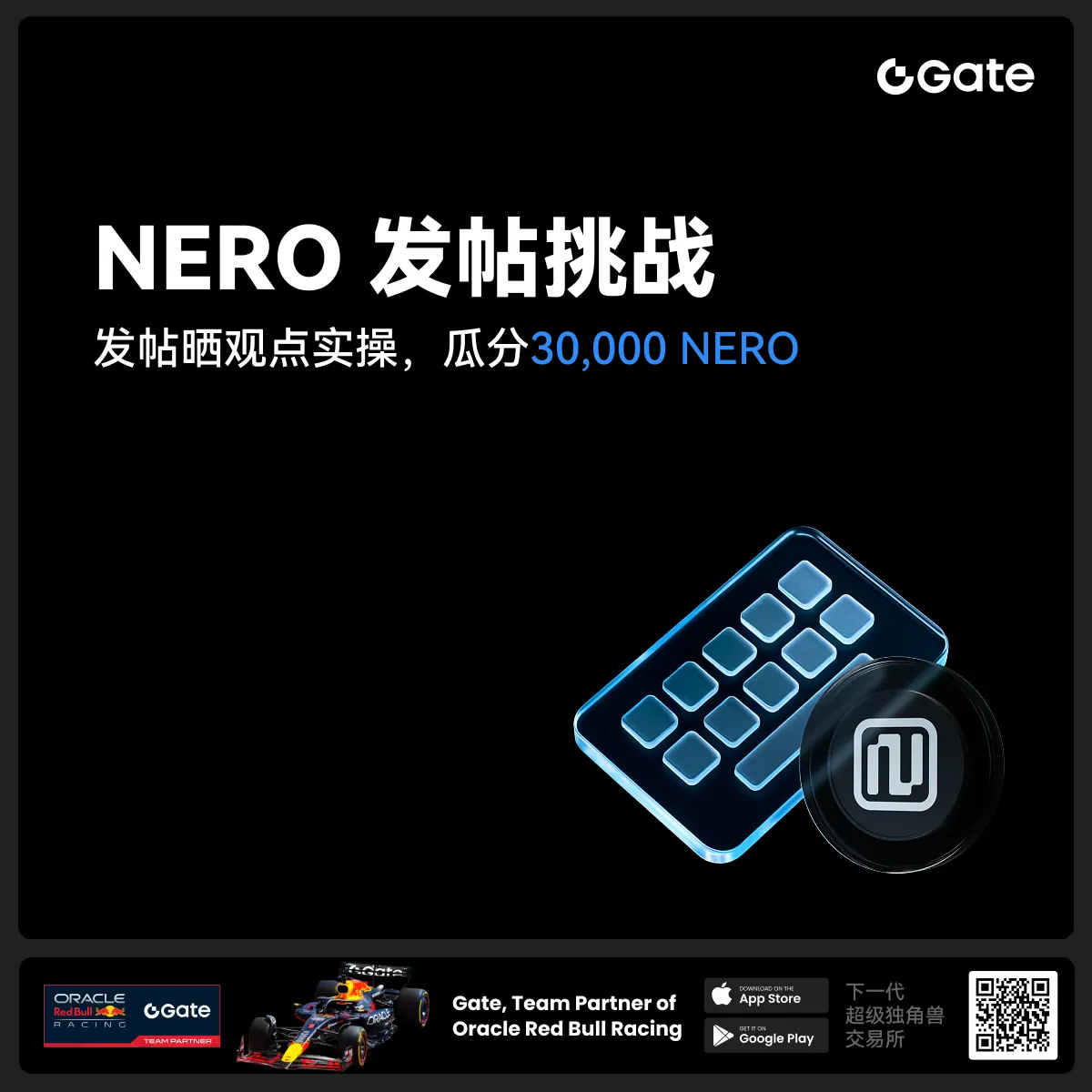- 話題1/3
16253 熱度
8491 熱度
33037 熱度
7089 熱度
21630 熱度
- 置頂
- 🎉 #CandyDrop合约挑战# 正式開啓!參與即可瓜分 6 BTC 豪華獎池!
📢 在 Gate 廣場帶話題發布你的合約體驗
🎁 優質貼文用戶瓜分$500 合約體驗金券,20位名額等你上榜!
📅 活動時間:2025 年 8 月 1 日 15:00 - 8 月 15 日 19:00 (UTC+8)
👉 活動連結:https://www.gate.com/candy-drop/detail/BTC-98
敢合約,敢盈利
- 🎉 攢成長值,抽華爲Mate三折疊!廣場第 1️⃣ 2️⃣ 期夏季成長值抽獎大狂歡開啓!
總獎池超 $10,000+,華爲Mate三折疊手機、F1紅牛賽車模型、Gate限量週邊、熱門代幣等你來抽!
立即抽獎 👉 https://www.gate.com/activities/pointprize?now_period=12
如何快速賺成長值?
1️⃣ 進入【廣場】,點擊頭像旁標識進入【社區中心】
2️⃣ 完成發帖、評論、點讚、發言等日常任務,成長值拿不停
100%有獎,抽到賺到,大獎等你抱走,趕緊試試手氣!
截止於 8月9日 24:00 (UTC+8)
詳情: https://www.gate.com/announcements/article/46384
#成长值抽奖12期开启#
- 📢 Gate廣場 #NERO发帖挑战# 秀觀點贏大獎活動火熱開啓!
Gate NERO生態周來襲!發帖秀出NERO項目洞察和活動實用攻略,瓜分30,000NERO!
💰️ 15位優質發帖用戶 * 2,000枚NERO每人
如何參與:
1️⃣ 調研NERO項目
對NERO的基本面、社區治理、發展目標、代幣經濟模型等方面進行研究,分享你對項目的深度研究。
2️⃣ 參與並分享真實體驗
參與NERO生態周相關活動,並曬出你的參與截圖、收益圖或實用教程。可以是收益展示、簡明易懂的新手攻略、小竅門,也可以是行情點位分析,內容詳實優先。
3️⃣ 鼓勵帶新互動
如果你的帖子吸引到他人參與活動,或者有好友評論“已參與/已交易”,將大幅提升你的獲獎概率!
NERO熱門活動(帖文需附以下活動連結):
NERO Chain (NERO) 生態周:Gate 已上線 NERO 現貨交易,爲回饋平台用戶,HODLer Airdrop、Launchpool、CandyDrop、餘幣寶已上線 NERO,邀您體驗。參與攻略見公告:https://www.gate.com/announcements/article/46284
高質量帖子Tips:
教程越詳細、圖片越直觀、互動量越高,獲獎幾率越大!
市場見解獨到、真實參與經歷、有帶新互動者,評選將優先考慮。
帖子需原創,字數不少於250字,且需獲得至少3條有效互動
- 🎉 親愛的廣場小夥伴們,福利不停,精彩不斷!目前廣場上這些熱門發帖贏獎活動火熱進行中,發帖越多,獎勵越多,快來GET你的專屬好禮吧!🚀
1️⃣ #GateLaunchpad上线IKA# |IKA認購體驗
在Gate廣場帶話題曬出你的IKA Launchpad認購體驗,4位幸運分享者講瓜分$200分享獎池!
詳情 👉️ https://www.gate.com/post/status/12566958
2️⃣ #ETH冲击4800# |行情分析預測
大膽發帖預測ETH走勢,展示你的市場洞察力!10位幸運用戶將平分0.1 ETH 獎勵!
詳情 👉️ https://www.gate.com/post/status/12322403
3️⃣ #创作者活动第二期# |ZKWASM話題
在廣場或推特發布與 ZKWASM 或其交易活動相關的原創內容,瓜分4,000枚ZKWASM!
詳情 👉️ https://www.gate.com/post/status/12525794
4️⃣ #Gate广场征文活动第二期# |ERA話題
談談你對ERA的觀點/體驗,參與並推廣活動,700 ERA大獎等你贏!
詳情 👉️ https://www.gate.com/post/status/12361653
5️⃣ #MBG任务挑战# |MBG話題
分享你對MBG的洞察,積極參與和推廣MBG活動,20位小 - 🎉Gate 2025 上半年社區盛典:內容達人評選投票火熱進行中 🎉
🏆 誰將成爲前十位 #Gate广场# 內容達人?
投票現已開啓,選出你的心頭好
🎁贏取 iPhone 16 Pro Max、限量週邊等好禮!
📅投票截止:8 月 15 日 10:00(UTC+8)
立即投票: https://www.gate.com/activities/community-vote
活動詳情: https://www.gate.com/announcements/article/45974
Web3 AI新紀元:從泡沫破滅到真實價值崛起
AI Agent泡沫破滅後:Web3 AI的真正價值在哪裏?
引言
2023年第四季度,AI代理人賽道迅速崛起,市值從幾乎爲零飆升至200億美元以上。各種"智能體"一時間爆火,從搞笑的到搞怪的應有盡有。人們開始憧憬能自動炒幣、幫你賺錢的"金融代理人",還出現了各種號稱要投資其他代理人的項目,甚至有"人類與代理人共治"的組織,玩法花樣百出,讓人覺得一夜暴富指日可待。
然而,風口來得快去得也快。泡沫破裂後,許多項目接連倒閉。不過,一些具有實用價值的AI基礎設施項目正在逐漸佔據市場主導地位。真正的價值開始顯現,下一波Web3 AI浪潮正在醞釀,這次可能不僅僅是炒作—值得我們認真關注。
衆所周知,每當出現新的賽道或熱點(如Web2 AI、川普支持加密貨幣和AI這類組合),市場往往不會過多關注基本面。只要項目看起來熱鬧、有噱頭、Demo漂亮,不管實際用處大小,市值都能輕鬆衝到上億美元。
在這波浪潮中,某些項目擅長講故事,精準把握市場、佔據用戶心智,敘事能力出衆。於是開發者紛紛在其平台上發布項目,散戶也跟風炒作。
後來又有項目採取了完全不同的路線——開源AI,讓任何開發者都能輕鬆上手,自己動手創造價值。這個理念迅速引發廣泛共鳴,社區快速壯大,GitHub上的star和fork數量急劇增長(至今仍在持續上升)。
某生態的總估值曾一度衝到50億美元以上,另一個項目高峯期也接近這個體量的一半。其他一些有趣的AI代理人項目,市值也曾一度突破10億美元。
當然,現在的市場環境已經完全不同了。新發布的、表現不錯的代理人項目,市值大多在300萬到1000萬美元之間;老項目的市值也壓縮到1000萬到5000萬美元區間。整個板塊的估值上限被壓縮,總市值也從巔峯時期的200億美元下降到現在的40-60億美元區間。
第一部分:基礎設施崛起,Web2 AI加速發展
如今的市場不再迷信那些"看起來厲害"的泡沫項目,而是開始關注真正的基本面。特別是在Web2的AI模型發展日新月異的背景下,人們更加關注基礎設施和去中心化AI的長期價值。
各大科技公司的AI模型幾乎每月都在更新迭代,變得更強大、更快速、更智能。比如最近某聊天機器人的圖像生成功能一上線,立即引發了"吉卜力風"圖片的熱潮,迅速在社交媒體上刷屏。
Web2的消費者產品端也在飛速進化。由於底層AI能力的增強,許多以前無法實現的產品體驗現在都成爲可能。一些新工具讓開發者的效率提升了幾個檔次,功能更新又快又多。AI代理人和智能工作流現在已經滲透到各個角落,而且入門門檻越來越低。對用戶來說,更換工具幾乎沒有成本—如果某個工具不好用或價格昂貴,立即就能找到UI更好、體驗更順暢的替代品。整個市場競爭越來越激烈,但也推動了真正有價值的產品加速落地。
第二部分:數據主權覺醒:誰才是真正的數據主人?
在這一切高速發展的同時,越來越多的人開始意識到一個問題:現在到處都是各種AI代理應用,但它們大多數使用的都是中心化技術—那麼我的數據到底歸誰所有?我的聊天記錄會去哪裏?如果我跟AI聊了一些私密內容,它真的會保密嗎?還是會被上傳、分析、用於訓練其他模型?
這個問題在某AI公司最近的更新之後顯得更加關鍵—其聊天機器人的"記憶功能"現在可以引用你過去所有的對話,生成更個性化的回應。這功能確實很酷,想象一下,未來每個人都有自己的AI私人助理、聊天伴侶、情感支持...但這也意味着,你的數據會被某個平台"長期持有",你不再是數據的主人。
一旦他人控制了你的對話、偏好、情緒甚至生活習慣,那後果可能就不只是"體驗更好"那麼簡單了。
這也是爲什麼"數據主權"這個話題,正在成爲AI+Web3的下一個重點。真正屬於用戶的數據,才是最有價值的未來。
第三部分:去中心化AI(DeAI)的崛起
去年就有預測認爲,到2025年第二季度,去中心化AI會真正走入大衆視野。尤其是在大家對隱私安全、數據所有權越來越重視的背景下,那些能提供保密性、可驗證性、用戶數據歸屬透明性的底層基礎設施會獲得更多關注和使用。
目前我們看到三個主要方向的趨勢正在浮現:
一、Web2 AI的風投趨勢
二、Web3 AI的風投趨勢
三、Web3 AI的散戶趨勢
這些趨勢交織在一起,共同推動DeAI從概念走向實用階段。2025年將是驗證去中心化AI價值的關鍵時刻。
第四部分:Web2 vs Web3 AI:完全不同的節奏和玩法
Web2的AI市場體量遠大於Web3。因爲有太多傳統企業正在尋求通過AI來轉型,優化自己的業務流程—比如:獲取更多客戶、提升轉化率、增加銷售額等。這類企業通常都有很明確的需求,很多還集中在某個細分領域裏,所以他們希望找到能精準解決自己"特定痛點"的AI工具。這也吸引了很多年輕創業者,瞄準這些細分需求去做垂直領域AI代理人。
相比傳統SaaS,AI代理人能帶來的效益更直接—要麼省一大筆錢,要麼直接吸引更多客戶賺錢。所以,這類AI工具的訂閱價格也能賣得更貴,很多初創公司上線幾個月就達到年營收百萬、千萬美金,這並非沒有道理。
但Web3的玩法完全不同。區塊鏈本身就是爲去中心化AI(DeAI)量身定做的基礎層。所有行爲可以鏈上驗證,不可篡改;天然提供去信任的環境;支持去中心化的計算;用戶可以真正擁有自己的數據、模型和使用場景。簡單來說,Web3 AI的未來將讓用戶了解自己的數據被如何使用、理解AI的決策過程、自主掌控模型和用例,還能從中獲利。
Web3的風投機構已經開始爲這種未來布局。
第五部分:爲什麼散戶喜愛AI代理人
對Web3散戶來說,DeAI(去中心化AI)確實比較難理解:一堆新詞新概念,聽起來像外星語言。所以最初他們最容易被吸引的,是那些容易理解、有趣好玩的AI代理人—比如會說話的聊天機器人,能講段子會搞笑的那種。這種"娛樂型AI代理人"確實很吸引人,但時間一長,散戶也開始發現這些東西似乎沒什麼真正用處。再加上這段時間市場行情不佳,大量無用的項目慢慢被淘汰,而那些有實際價值、能提供功能的代理人雖然估值也下降了,但仍然存活。
這波"清洗"讓越來越多人意識到:只有具備實際用例和核心產品能力的AI項目才有未來。於是,項目方開始轉向兩個方向。要麼自己開發真正的AI產品,解決實際問題;要麼與真正有技術、有價值的DeAI項目合作。
這種轉變有兩個積極意義:讓大家開始關注原本"看不懂"的底層基礎設施;讓AI代理人不再只是表演工具,而是能做實事的產品。一些項目已經成爲典型案例—不僅功能強大,還順帶把一些酷炫的DeAI技術帶到了大衆視野中。這表明一個趨勢:散戶雖然不懂技術,但他們會慢慢被"真正有用"的產品教育。
有些DeAI項目最有趣的一點是,它們是普通人也能參與投資的去中心化AI生態系統。目前大多數DeAI項目還處於早期階段,只有風投或"圈內戰略合作夥伴"才能投資,很多項目甚至還沒有發行代幣。但某些項目不一樣。用戶可以直接用代幣投票支持看好的子網(subnet),相當於提前參與這些DeAI項目的子代幣。
盡管這些項目的跨鏈橋、交易體驗可能還有些麻煩,但它們的底層技術、產品邏輯,以及整體氛圍確實很強。特別是某些團隊的存在,讓整個生態的用戶體驗設計朝着更加友好的方向發展。因爲在某些項目的機制中,每個子網要想獲得更多獎勵(挖礦激勵),就得靠市場認可—誰有用、誰厲害,誰才能獲得更多分發。
所以,對這些子網來說,"讓用戶理解你在做什麼"變得至關重要。一些團隊正在做這件事。他們的產品方向非常明確:爲普通用戶優化界面和用戶體驗。他們不僅有多個實用的子網(比如一個超級方便的AutoML平台,用戶可以直接在上面訓練模型,只需點擊幾個按鈕就能運行起來),還推出了一些非常酷的旗艦產品:比如AI代理人平台,你可以像拖拽圖塊一樣創建AI代理,真正做到"零代碼搭建AI代理人"。這種體驗有點像Web3版的"傻瓜式AI工廠",非常適合不懂技術的用戶入門。
總的來說,某些DeAI生態系統不僅在技術上處於領先地位,而且在普通用戶參與的友好度上也走在前列。這種產品邏輯清晰、用戶友好的團隊,正是讓這個生態變得有吸引力的關鍵角色。
我們正處在一個由Web3 AI主導的大變革時代。過去那種靠炒作拉高市值的泡沫已被實際的基礎設施、去中心化AI和真實的應用場景所取代。無論是企業在Web2裏利用AI優化業務,還是散戶在Web3裏體驗新型代理人的便捷,未來的數據主權和用戶參與都將成爲關鍵。Web3 AI還遠遠沒到高潮。真正的戲,才剛剛開始。